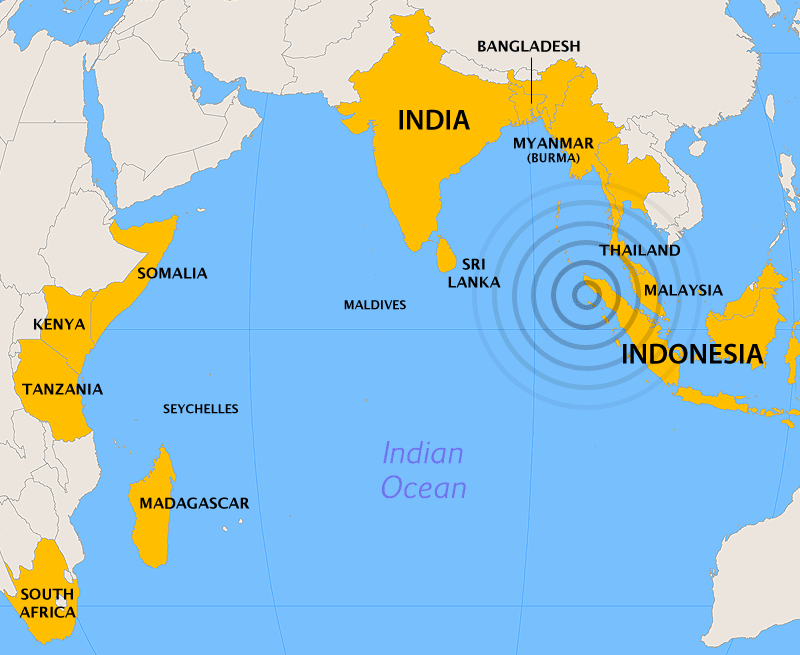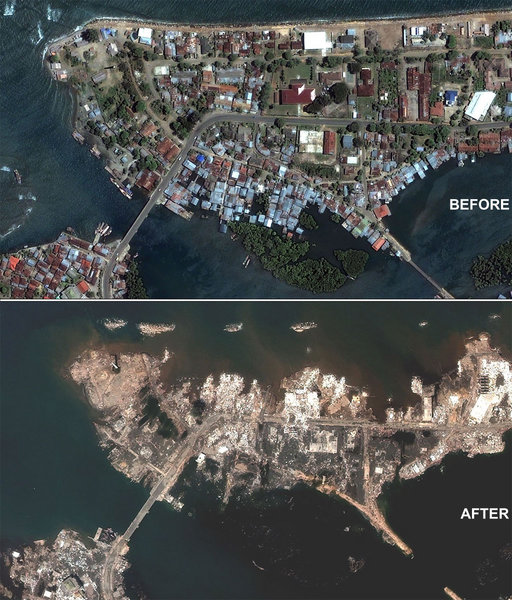2004 Indian Ocean earthquake
The 2004 Indian Ocean earthquake, known by the scientific community as the Sumatra-Andaman earthquake, was an undersea earthquake that occurred at 00:58:53 UTC (07:58:53 local time) on December 26, 2004. The earthquake generated a tsunami that was among the deadliest disasters in modern history, killing well over 200,000 people.
Various values were given for the magnitude of the earthquake, ranging from 9.0 to 9.3 (which would make it the second largest earthquake ever recorded on a seismograph), though authoritative estimates now put the magnitude at 9.15.

In May 2005, scientists reported that the earthquake itself lasted nearly ten minutes when most major earthquakes last no more than a few seconds; it caused the entire planet to vibrate at least a few centimetres. It also triggered earthquakes elsewhere, as far away as Alaska .
 The earthquake originated in the Indian Ocean just north of Simeulue island, off the western coast of northern Sumatra, Indonesia. The resulting tsunami devastated the shores of Indonesia, Sri Lanka, South India, Thailand and other countries with waves up to 30 m (100 feet). It caused serious damage and deaths as far as the east coast of Africa, with the furthest recorded death due to the tsunami occurring at Port Elizabeth in South Africa, 8,000km (5,000 miles) away from the epicentre.
The earthquake originated in the Indian Ocean just north of Simeulue island, off the western coast of northern Sumatra, Indonesia. The resulting tsunami devastated the shores of Indonesia, Sri Lanka, South India, Thailand and other countries with waves up to 30 m (100 feet). It caused serious damage and deaths as far as the east coast of Africa, with the furthest recorded death due to the tsunami occurring at Port Elizabeth in South Africa, 8,000km (5,000 miles) away from the epicentre.
Devastation to Banda Aceh on the island of Sumatra as a result of the tsunami caused by the 2004 Indian Ocean earthquake (Credit: DigitalGlobe)
Anywhere from 200,000 to 310,000 people are thought to have died as a result of the tsunami, and the count is not yet complete. In Indonesia in particular, 500 bodies a day were still being found in February 2005 and the count was expected to continue past June . The true final toll may never be known due to bodies having been swept out to sea, but current estimates use conservative methodologies. Relief agencies warn of the possibility of more deaths to come as a result of epidemics caused by poor sanitation, but the threat of starvation seems now to have been largely averted. The plight of the many affected people and countries prompted a widespread humanitarian response.